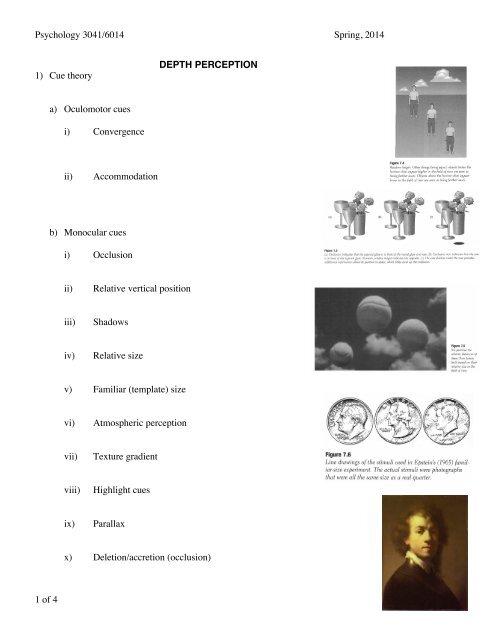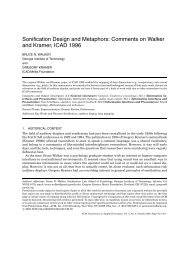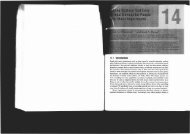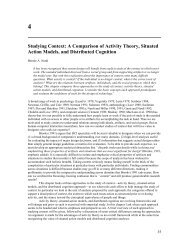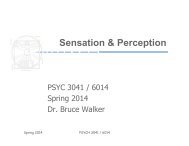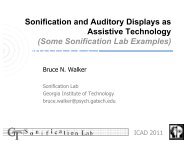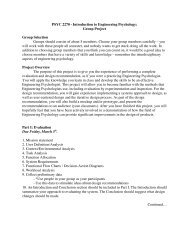Psychology 3041/6014 Spring, 2013 1 of 4 DEPTH PERCEPTION 1 ...
Psychology 3041/6014 Spring, 2013 1 of 4 DEPTH PERCEPTION 1 ...
Psychology 3041/6014 Spring, 2013 1 of 4 DEPTH PERCEPTION 1 ...
Create successful ePaper yourself
Turn your PDF publications into a flip-book with our unique Google optimized e-Paper software.
<strong>Psychology</strong> <strong>3041</strong>/<strong>6014</strong> <strong>Spring</strong>, 2014<br />
1) Cue theory<br />
<strong>DEPTH</strong> <strong>PERCEPTION</strong><br />
a) Oculomotor cues<br />
i) Convergence<br />
ii)<br />
Accommodation<br />
b) Monocular cues<br />
i) Occlusion<br />
ii)<br />
Relative vertical position<br />
iii)<br />
Shadows<br />
iv)<br />
Relative size<br />
v) Familiar (template) size<br />
vi)<br />
Atmospheric perception<br />
vii)<br />
Texture gradient<br />
viii)<br />
Highlight cues<br />
ix)<br />
Parallax<br />
x) Deletion/accretion (occlusion)<br />
1 <strong>of</strong> 4
<strong>Psychology</strong> <strong>3041</strong>/<strong>6014</strong> <strong>Spring</strong>, 2014<br />
c) Binocular cues<br />
i) Convergence <strong>of</strong> eyes<br />
ii)<br />
Binocular disparity<br />
(1) Disparity leads to stereopsis<br />
(2) Separation can be done by<br />
(a) Physically separate images presented<br />
(b) Different colored images<br />
(c) Polarization<br />
(3) Computation <strong>of</strong> depth from disparity<br />
(4) Horopter<br />
(5) Random dot stereogram<br />
2 <strong>of</strong> 4
<strong>Psychology</strong> <strong>3041</strong>/<strong>6014</strong> <strong>Spring</strong>, 2014<br />
2) Neural basis <strong>of</strong> depth perception<br />
a) Disparity detectors in striate cortex (V1)<br />
i) Fixation plane<br />
ii)<br />
“nearer” detectors<br />
iii)<br />
“farther” detectors<br />
iv)<br />
also: present in:<br />
(1) dorsal (where/how) pathway (V2, MT)<br />
(2) ventral (what) pathway<br />
b) Stereoblindness<br />
c) Development <strong>of</strong> stereopsis<br />
3 <strong>of</strong> 4
<strong>Psychology</strong> <strong>3041</strong>/<strong>6014</strong> <strong>Spring</strong>, 2014<br />
3) Interaction <strong>of</strong> cues<br />
a) Constructivist approach<br />
b) Gibson’s Direct Perception approach<br />
c) One cue vs. another<br />
4 <strong>of</strong> 4


